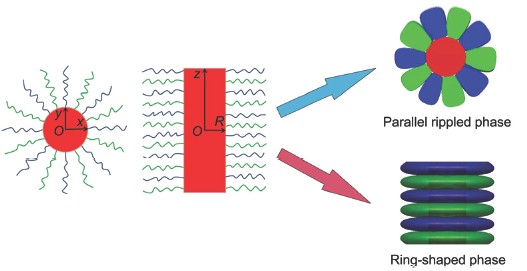| [1] Zhao, B.; Brittain, W. J. Prog. Polym. Sci. 2000, 25(5), 677.[2] Marko, J. F.; Witten, T. A. Phys. Rev. Lett. 1991, 66(11), 1541.[3] Zhao, B.; Zhu, L. Macromolecules 2009, 42(24), 9369.[4] Minko, S.; Müller, M.; Usov, D.; Scholl, A.; Froeck, C.; Stamm, M. Phys. Rev. Lett. 2002, 88(3), 5502.[5] Lai, P. Y. J. Chem. Phys. 1994, 100(4), 3351.[6] Matsen, M. W.; Schick, M. Phys. Rev. Lett. 1994, 72(16), 2660.[7] Matsen, M. W. Phys. Rev. Lett. 1995, 74(21), 4225.[8] Matsen, M. W. Macromolecules 1995, 28(17), 5765.[9] Clayfiel.Ej; Lumb, E. C. J. Colloid Interface Sci. 1966, 22(3), 269.[10] Clayfiel.Ej; Lumb, E. C. J. Colloid Interface Sci. 1966, 22(3), 285.[11] Mackor, E. L. J. Colloid Sci. 1951, 6(5), 492.[12] Mackor, E. L.; Vanderwaals, J. H. J. Colloid Sci. 1952, 7(5), 535.[13] Vanderwaarden, M. J. Colloid Sci. 1950, 5(4), 317.[14] Vanderwaarden, M. J. Colloid Sci. 1950, 5(5), 448.[15] Vanderwaarden, M. J. Colloid Sci. 1951, 6(5), 443.[16] Gross, N. A.; Zhulina, E.; Balazs, A. C. J. Chem. Phys. 1996, 104(2), 727.[17] Szleifer, I.; Carignano, M. A. Adv. Chem. Phys., Vol Xciv 1996, 94, 165.[18] Hong, J.; Degennes, P. G. Macromolecules 1993, 26(3), 520.[19] Amiji, M.; Park, K. J. Biomater. Sci.-Polym. Ed. 1993, 4(3), 217.[20] Vanzanten, J. H. Macromolecules 1994, 27(23), 6797.[21] Joanny, J. F. Langmuir 1992, 8(3), 989.[22] Milner, S. T. Science 1991, 251(4996), 905.[23] Lai, P. Y. J. Chem. Phys. 1993, 98(1), 669.[24] Lai, P. Y.; Binder, K. J. Chem. Phys. 1991, 95(12), 9288.[25] Lai, P. Y.; Binder, K. J. Chem. Phys. 1993, 98(3), 2366.[26] Lai, P. Y.; Halperin, A. Macromolecules 1991, 24(17), 4981.[27] Marko, J. F.; Witten, T. A. Macromolecules 1992, 25(1), 296.[28] Müller, M. Phys. Rev. E 2002, 65(3), 030802.[29] Zhao, B.; Haasch, R. T.; MacLaren, S. J. Am. Chem. Soc. 2004, 126(19), 6124.[30] Soga, K. G.; Zuckermann, M. J.; Guo, H. Macromolecules 1996, 29(6), 1998.[31] Zhao, B.; Brittain, W. J.; Zhou, W. S.; Cheng, S. Z. D. Macromolecules 2000, 33(23), 8821.[32] Zhao, B.; Brittain, W. J. Macromolecules 2000, 33(23), 8813.[33] Zhao, B.; He, T. Macromolecules 2003, 36(23), 8599.[34] Zhao, B. Langmuir 2004, 20(26), 11748.[35] Ohno, K.; Koh, K.; Tsujii, Y.; Fukuda, T. Angew. Chem.-Int. Ed. 2003, 42(24), 2751.[36] Wang, B. B.; Li, B.; Zhao, B.; Li, C. Y. J. Am. Chem. Soc. 2008, 130(35), 11594.[37] Farmer, S. C.; Patten, T. E. Chem. Mater. 2001, 13(11), 3920.[38] Sill, K.; Emrick, T. Chem. Mater. 2004, 16(7), 1240.[39] Zhu, M. Q.; Wang, L. Q.; Exarhos, G. J.; Li, A. D. Q. J. Am. Chem. Soc. 2004, 126(9), 2656.[40] Vestal, C. R.; Zhang, Z. J. J. Am. Chem. Soc. 2002, 124(48), 14312.[41] Matsuno, R.; Yamamoto, K.; Otsuka, H.; Takahara, A. Macromolecules 2004, 37(6), 2203.[42] Chanana, M.; Jahn, S.; Georgieva, R.; Lutz, J. F.; Baumler, H.; Wang, D. Y. Chem. Mater. 2009, 21(9), 1906.[43] Papaphilippou, P.; Loizou, L.; Popa, N. C.; Han, A.; Vekas, L.; Odysseos, A.; Krasia-Christoforou, T. Biomacromolecules 2009, 10(9), 2662.[44] Wang, B. B.; Li, B.; Dong, B.; Zhao, B.; Li, C. Y. Macromolecules 2010, 43(22), 9234.[45] von Werne, T.; Patten, T. E. J. Am. Chem. Soc. 1999, 121(32), 7409.[46] Prucker, O.; Ruhe, J. Macromolecules 1998, 31(3), 592.[47] Prucker, O.; Ruhe, J. Macromolecules 1998, 31(3), 602.[48] Wang, Y. Q.; Yang, G. A.; Tang, P.; Qiu, F.; Yang, Y. L.; Zhu, L. J. Chem. Phys. 2011, 134(13), 134903.[49] Ma, X.; Yang, Y. Z.; Zhu, L.; Zhao, B.; Tang, P.; Qiu, F. J. Chem. Phys. 2013, 139, 214902.[50] Egorov, S. A. Soft Matter 2012, 8(14), 3971.[51] Egorov, S. A.; Binder, K. J. Chem. Phys. 2012, 137(9), 094901.[52] Netz, R. R.; Schick, M. Macromolecules 1998, 31, 5105. |
